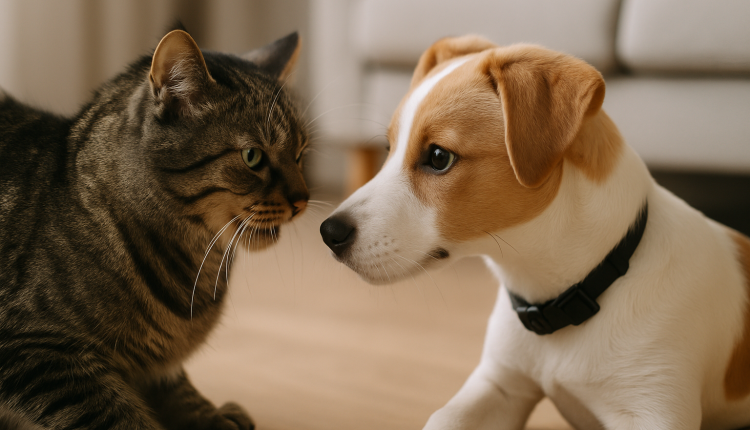Bringing a new pet into your home is exciting — but if your household already includes a cat, the introduction of a dog can quickly turn from joyful to chaotic. While pop culture often exaggerates the idea that cats and dogs are natural enemies, the truth is: many of them coexist peacefully and even form deep bonds. But that harmony doesn’t happen overnight.
Successfully introducing a cat to a dog — or vice versa — requires patience, structure, and understanding the instincts of both species. Whether you’re adopting a puppy or welcoming a rescue dog into your cat’s territory, here’s how to navigate those crucial early days and build a foundation for lifelong friendship.
Step 1: Understand the Natural Differences
Before the first sniff, it helps to know what you’re working with.
- Cats are territorial, easily startled, and often prefer to retreat when overwhelmed.
- Dogs, especially puppies or high-energy breeds, are more social, curious, and tend to greet with enthusiasm — which a cat may read as a threat.
Recognizing these fundamental differences helps manage expectations and avoid forcing interactions too soon.
Step 2: Prepare the Environment
Before any face-to-face meeting:
- Create separate zones. Your cat should have access to high places, escape routes, and quiet areas the dog can’t reach.
- Use scent swapping. Rub a soft cloth on the dog, then place it near the cat’s sleeping area — and vice versa. This allows each animal to explore the other’s scent in a stress-free way.
- Feeding near the door. Start feeding both animals on opposite sides of a closed door. This creates a positive association: “I smell that new animal and get food = good.”
This “indirect introduction” phase can last several days or even weeks, depending on how sensitive your cat is.
Step 3: Controlled First Meeting
Once both animals seem relaxed around each other’s scent:
- Keep the dog on a leash. Even the friendliest dog can be too much for a nervous cat.
- Let the cat roam freely. Never force them to come close. The cat should always have an easy escape route.
- Keep meetings short. 5–10 minutes at a time is plenty in the beginning. End on a calm note and gradually increase duration.
Watch for signs of stress:
- Dog: fixated stare, whining, lunging
- Cat: hissing, flattened ears, tail flicking, hiding
If either shows signs of distress, pause and try again later.
Step 4: Positive Reinforcement and Boundarie
- Reward calm behavior. Praise and treat both animals when they behave calmly in each other’s presence.
- Discourage chasing. If the dog tries to chase the cat, gently interrupt with a verbal cue like “Leave it” and redirect attention to a toy.
- Don’t punish growls or hisses. These are normal communication signals. Punishment can increase anxiety.
Your goal isn’t immediate friendship — it’s calm tolerance. Affection may come later.
Step 5: Gradual Integration
Over time, begin allowing them to share space off-leash — but only when supervised. Continue to:
- Feed them in the same room but at a distance.
- Allow short playtimes or parallel activities like lounging near each other.
- Keep their sleeping and litter areas separate — cats need privacy.
If progress stalls, return to earlier steps. Every animal has their own pace.
When Things Go Smoothly — or Not
Signs your cat and dog are becoming friends:
- Curious sniffing without aggression
- Relaxed body language
- Sharing space (even if not touching)
- Mutual grooming or sleeping nearby (eventually)
Signs of incompatibility:
- Persistent aggression from either pet
- Cat refuses to come out or eat
- Dog obsessively fixated on the cat despite training
If problems persist after several weeks, consult a professional behaviorist.
Final Tips for Success
- Age matters. Puppies are often easier to introduce than adult dogs, but senior cats may take more time to adjust.
- Breed matters. Herding or prey-driven dogs (like terriers or huskies) may need extra guidance.
- Energy levels. Try to match energy: a calm dog may be a better match for a shy cat.
In Conclusion
With patience, empathy, and a structured approach, your cat and dog can go from uneasy strangers to trusted companions. While not every cat-dog relationship ends in cuddles, many do — and even those that don’t often settle into a peaceful coexistence that makes your home a happier place for all.
The key? Don’t rush it. Let trust build slowly — one sniff, one glance, one shared room at a time.

